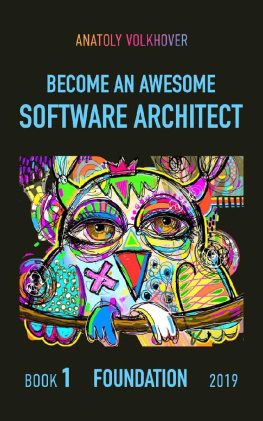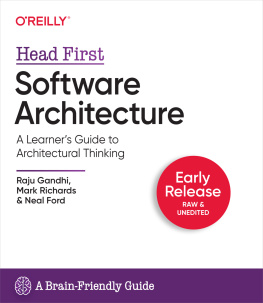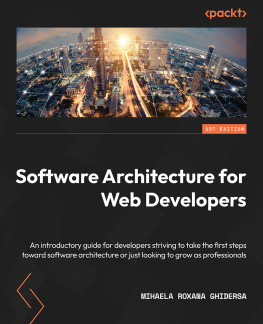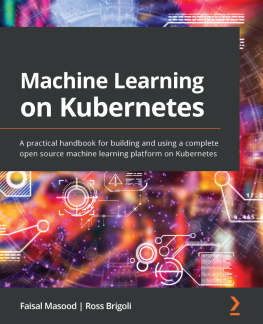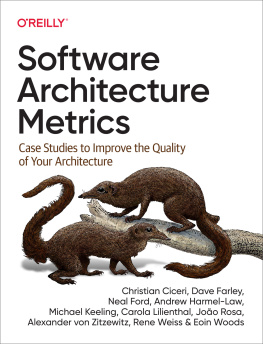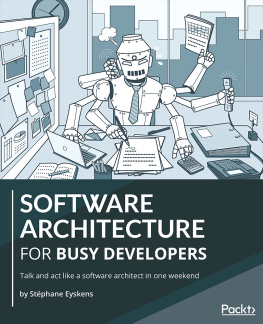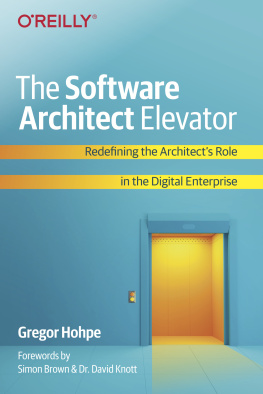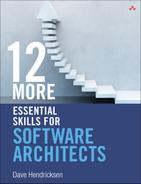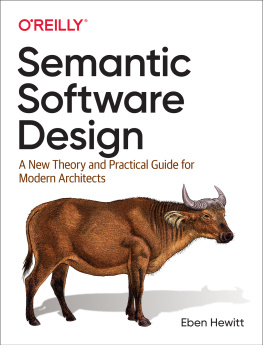Anatoly Volkhover - Become an Awesome Software Architect: Book 1: Foundation 2019
Here you can read online Anatoly Volkhover - Become an Awesome Software Architect: Book 1: Foundation 2019 full text of the book (entire story) in english for free. Download pdf and epub, get meaning, cover and reviews about this ebook. year: 2019, publisher: Independently published, genre: Home and family. Description of the work, (preface) as well as reviews are available. Best literature library LitArk.com created for fans of good reading and offers a wide selection of genres:
Romance novel
Science fiction
Adventure
Detective
Science
History
Home and family
Prose
Art
Politics
Computer
Non-fiction
Religion
Business
Children
Humor
Choose a favorite category and find really read worthwhile books. Enjoy immersion in the world of imagination, feel the emotions of the characters or learn something new for yourself, make an fascinating discovery.
- Book:Become an Awesome Software Architect: Book 1: Foundation 2019
- Author:
- Publisher:Independently published
- Genre:
- Year:2019
- Rating:3 / 5
- Favourites:Add to favourites
- Your mark:
Become an Awesome Software Architect: Book 1: Foundation 2019: summary, description and annotation
We offer to read an annotation, description, summary or preface (depends on what the author of the book "Become an Awesome Software Architect: Book 1: Foundation 2019" wrote himself). If you haven't found the necessary information about the book — write in the comments, we will try to find it.
Great software architects arent born. They are a product of decades of building real-life solutions and relentless learning. They become really good at their trade closer to the retirement age. But most startups are fostered by young entrepreneurs who dare to try but lack the experience. They also lack the $$ to hire a silver-haired architect to join their team from day one. Left to their own faculties, the entrepreneurs and their engineering teams quickly get on the path of learning from their own mistakes. Eventually, they discover this is the most expensive way of learning. Over time they get better, and some become the true masters of the craft but way too late to make a difference for their early-day projects.
This book is meant to break the vicious circle. It isnt a textbook, at least not in the traditional sense. It is a business-centric practical guide to software architecture, intended for software engineers, technology executives, students of computer science, and tech-savvy entrepreneurs who want to de-risk their entrepreneurial endeavors or to fast-track their careers in software engineering. The recipes in this book are highly practical, battle-tested, and current for building mid- to large-scale systems in 2019-2020.
The book covers the following topics:
- Software architecture, what it is, and what its for
- The Hit List of a software architect; functional vs non-functional requirements
- Programming languages; object-oriented vs functional programming; how to pick the right tool for a job
- Datastores, SQL vs NoSQL vs Event Stores, CRUD vs CQRS vs Append-Only
- Data Models, Domain-Driven Design approach to data modeling
- Layering your architecture, reducing complexity and dependencies
- Code composition, SOLID principles
- Dependency inversion demystified
- Latency; synchronous and asynchronous processing
- Errors, error recovery, and the right way of handling retries
- Practical approach to logging
- Real-time and near-real-time processing
- Event streaming and streaming architectures
- Caching and CDNs
- User Interfaces, unified cross-platform UI architectures
- MVC model and its successors; a reusable UI composition model
- Microservices, the Dos and the Donts
- API design patterns, API versioning, and backward compatibility
- API security
- Batch processing, and how to eliminate it
- Multi-tenancy, and why it is more important than you might think
- Removing dependencies between engineering workstreams, develop great code fast with a team of any size
- Runtime infrastructures, from dedicated servers to cloud to serverless architectures
- Runtime frameworks, how to pick one, and how to protect yourself from the frameworks shortcomings
- Brainstorming technique that really works
Every topic is illustrated with easy to follow code examples and diagrams. Enjoy!
Anatoly Volkhover: author's other books
Who wrote Become an Awesome Software Architect: Book 1: Foundation 2019? Find out the surname, the name of the author of the book and a list of all author's works by series.

